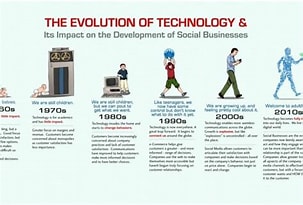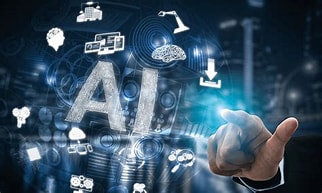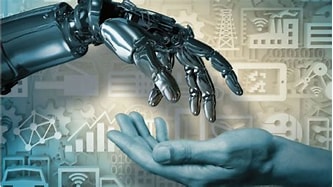Introduction: The Power of Technology in Human Civilization
We live in an era where technology is no longer just a luxury; it’s an essential part of our daily lives. From smartphones to artificial intelligence, technological advancements have revolutionized the way we communicate, work, and interact with the world. But what does this really mean for human civilization? How has technology shaped the trajectory of human history, and where is it taking us?
In this article, we will delve into the profound impact technology has had on human civilization, exploring how it has influenced society, culture, economy, and even the environment. Whether you’re aware of it or not, technology is continuously evolving and shaping the way we think, act, and live. Let’s explore its multifaceted impact and try to understand the bigger picture.

The Evolution of Technology: From Stone Tools to AI
Early Innovations: The Stone Age to the Agricultural Revolution
Human history began with simple tools, primarily made from stone. The earliest forms of technology—like the wheel, fire, and basic stone tools—allowed humans to enhance their survival. These inventions laid the foundation for the rapid progress we now see. Over time, humans moved from these rudimentary tools to more advanced forms of technology that helped them domesticate animals, grow crops, and build cities. The Agricultural Revolution marked one of the most significant technological breakthroughs, enabling humans to shift from nomadic lifestyles to settled farming communities.
Industrial Revolution: The Birth of Modern Technology
Fast forward to the late 18th century, and the Industrial Revolution dramatically reshaped society. The invention of machines like the steam engine and mechanized looms changed the nature of production and work. Factories sprouted, cities grew, and the global economy expanded rapidly. This era marked a turning point in human civilization, with technology transforming the way goods were produced, transported, and consumed. The effects of the Industrial Revolution can still be felt today, as it laid the groundwork for modern industries and technologies.
The Digital Revolution: Computers and the Internet
In the 20th century, the world witnessed the dawn of the Digital Revolution, which introduced personal computers, the internet, and smartphones. These technologies changed the landscape of communication, commerce, and entertainment. With the internet, information became accessible to almost anyone with a connection, leading to an explosion of knowledge and new industries. The digital era also saw the birth of artificial intelligence (AI), automation, and robotics, marking the beginning of the most significant technological shift in modern times.
How Technology Has Transformed Communication
Instant Communication Across the Globe
One of the most noticeable changes brought by technology is the way we communicate. The invention of the telephone, followed by the internet, has allowed people to communicate in real time, regardless of distance. Social media platforms, email, and instant messaging services have made it possible for people to stay connected and exchange information with just a few clicks.
Think about it: just a few decades ago, it could take days or even weeks to send a letter across the world. Now, you can communicate with someone across the globe within seconds. This has made the world feel smaller, fostering a sense of global interconnectedness.

The Role of Social Media in Shaping Public Opinion
Social media platforms like Facebook, Twitter, and Instagram have revolutionized how we share ideas and opinions. They have democratized information, allowing people from all walks of life to express their thoughts and connect with others. While this has empowered individuals, it has also introduced challenges, such as the spread of misinformation and the rise of digital echo chambers. Despite these concerns, social media continues to be an essential tool for shaping public opinion and influencing social movements.
Technology’s Impact on Education
Digital Learning: Making Education Accessible
Education has always been a key factor in human development, and technology has played a crucial role in expanding access to learning. Online courses, virtual classrooms, and educational apps have made learning more accessible than ever before. Students can now access lessons and resources from anywhere in the world, making education more inclusive and personalized.
For instance, platforms like Khan Academy, Coursera, and edX have democratized knowledge, allowing individuals in remote regions or underdeveloped areas to learn from top institutions without the need for physical classrooms. With the rise of artificial intelligence, educational tools can now be tailored to each student’s needs, offering a personalized learning experience.
The Rise of Remote Learning and Hybrid Models
The COVID-19 pandemic accelerated the shift toward remote learning, forcing schools and universities to adopt online education. As a result, technology enabled a smooth transition for students, teachers, and institutions. Even after the pandemic, remote learning continues to be a viable option for many, offering flexibility and a broader range of learning opportunities. The combination of in-person and online education—often referred to as hybrid learning—may become the new norm for many educational institutions worldwide.
Transforming Healthcare with Technology
Advances in Medical Technology
Technology has had a profound impact on healthcare, improving diagnostics, treatments, and overall patient care. Innovations such as MRI machines, robotic surgeries, and telemedicine have revolutionized the way healthcare providers diagnose and treat patients. AI is also being used to analyze medical data, helping doctors identify patterns and predict health issues before they become serious.
One of the most exciting advancements is the use of personalized medicine, where treatments are tailored to individual genetic profiles. This has led to breakthroughs in cancer treatment, where targeted therapies are being used to attack cancer cells while minimizing damage to healthy cells.

Telemedicine and Remote Patient Monitoring
With the rise of telemedicine, healthcare is no longer confined to hospital visits. Patients can consult with doctors remotely via video calls, saving time and increasing accessibility, especially for people in rural or underserved areas. Wearable devices like fitness trackers and smartwatches have also become part of the healthcare ecosystem, allowing people to monitor their health in real-time and share that data with medical professionals.
Technology’s Role in the Economy
The Shift Toward Automation and AI
Automation and AI have transformed industries across the world. While these technologies have increased efficiency and productivity, they have also raised concerns about job displacement. Machines and robots are now performing tasks once handled by humans, from manufacturing to customer service. However, the rise of automation also creates new opportunities in tech-related fields, such as AI development, machine learning, and data science.
E-Commerce and the Digital Economy
The rise of e-commerce has reshaped the global economy. Platforms like Amazon, eBay, and Alibaba have transformed how consumers shop and businesses operate. The convenience of shopping online has led to the closure of many brick-and-mortar stores, and entire industries have been disrupted by digital marketplaces. The digital economy continues to grow, with cryptocurrencies and blockchain technology also gaining prominence as alternatives to traditional financial systems.
The Environmental Impact of Technology
The Energy Consumption of Technology
While technology has led to numerous advancements, it also comes with its own set of challenges, particularly when it comes to the environment. The energy consumption required to power data centers, factories, and devices is immense. The rapid growth of digital technologies, such as cloud computing and AI, has contributed to an increase in global energy demand, which in turn exacerbates environmental concerns like climate change.
Sustainable Technologies: A Solution?
Despite these challenges, technology also offers potential solutions for environmental problems. Renewable energy sources like solar, wind, and hydroelectric power are becoming more efficient and affordable, making them viable alternatives to fossil fuels. Electric vehicles (EVs) are also gaining traction, reducing emissions and the environmental impact of traditional gasoline-powered cars. Additionally, innovations in carbon capture technology and waste management are helping to mitigate the effects of industrial activities on the environment.
Ethical Considerations in Technology
Data Privacy and Security
As we rely more on digital platforms, concerns about data privacy and security have become increasingly important. The collection of personal data by tech companies, coupled with frequent data breaches, has raised questions about how our private information is being used and protected. Governments and organizations are working to establish stricter data protection regulations to safeguard individuals’ privacy in the digital age.
The Rise of AI and Ethical Dilemmas
With the advancement of AI, we face new ethical dilemmas. Issues like AI bias, surveillance, and the potential for autonomous weapons are just the tip of the iceberg. As AI systems become more integrated into daily life, there is a growing need for regulations and ethical guidelines to ensure these technologies are used responsibly.
The Future of Technology and Human Civilization
The Role of AI and Automation in the Future
Looking ahead, AI and automation will continue to play a critical role in shaping the future of civilization. From self-driving cars to personalized health care, AI promises to revolutionize almost every aspect of life. However, this also raises questions about job displacement, economic inequality, and the role of humans in an increasingly automated world.
The Promise of Technology for Global Challenges
Despite the challenges, technology holds the potential to solve some of the world’s most pressing issues, from climate change to global health crises. Innovations in clean energy, precision agriculture, and medical research offer hope for a sustainable future. If used responsibly, technology can drive positive change and help tackle global challenges on a scale never seen before.
Conclusion: Impact of Technology on Human Civilization
Technology has indelibly shaped human civilization. From the creation of simple tools to the advent of artificial intelligence, each advancement has brought with it both opportunities and challenges. While technology has the power to enhance our lives in ways previously unimaginable, it also raises significant questions about ethics, privacy, and sustainability. As we move forward, it is essential for us to embrace the benefits of technology while addressing its challenges head-on, ensuring that we use it to build a better, more inclusive world.
FAQs
1. How has technology impacted human civilization? Technology has transformed human civilization by revolutionizing communication, healthcare, education, and the economy. It has led to greater efficiency, connectivity, and access to information.
2. What are the biggest technological advancements in history? Some of the most significant technological advancements include the invention of the wheel, the printing press, electricity, the internet, and artificial intelligence.
3. How has technology changed the job market? Technology, particularly automation and AI, has led to job displacement in some industries while creating new opportunities in tech-related fields like AI development, data science, and cybersecurity.
4. What ethical concerns arise from technology? Ethical concerns include data privacy, AI bias, and the potential misuse of technology in areas like surveillance and autonomous weapons.
5. How can technology help solve global problems? Technology offers solutions to global challenges such as climate change, healthcare access, and food security. Innovations like renewable energy, medical research, and precision agriculture can help address these issues.


